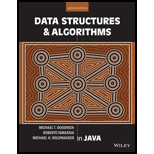
Data Structures and Algorithms in Java
6th Edition
ISBN: 9781118771334
Author: Michael T. Goodrich
Publisher: WILEY
expand_more
expand_more
format_list_bulleted
Expert Solution & Answer
Chapter 3, Problem 12R
Explanation of Solution
Method rotate() in Singly linked list:
//Define the rotate() method
public void rotate()
{
//Check whether the list is empty
if(isEmpty())
//Return it
return;
//Otherwise, execute else statement
else
{
/*Set the next node of "tail" as "head" after existing tail. */
tail.setNext((Node<E>) head);
}
/*Set the "tail" as "head"*/
tail=(Node<E>)head;
//Set next node of head as "head"
head = head...
Expert Solution & Answer
Learn your wayIncludes step-by-step video

schedule03:02
Students have asked these similar questions
I need to define and discuss the uses of one monitoring or troubleshooting tool in Windows Server 2019. thank you
I would likr toget help with the following concepts:
- Windows Server features
- Windows Server versus Windows 10 used as a client-server network
I need to define and discuss the uses of one monitoring or troubleshooting tool in Windows Server 2019. thank you
Chapter 3 Solutions
Data Structures and Algorithms in Java
Ch. 3 - Prob. 1RCh. 3 - Write a Java method that repeatedly selects and...Ch. 3 - Prob. 3RCh. 3 - The TicTacToe class of Code Fragments 3.9 and 3.10...Ch. 3 - Prob. 5RCh. 3 - Prob. 6RCh. 3 - Prob. 7RCh. 3 - Prob. 8RCh. 3 - Prob. 9RCh. 3 - Prob. 10R
Ch. 3 - Prob. 11RCh. 3 - Prob. 12RCh. 3 - Prob. 13RCh. 3 - Prob. 14RCh. 3 - Prob. 15RCh. 3 - Prob. 16RCh. 3 - Prob. 17CCh. 3 - Prob. 18CCh. 3 - Prob. 19CCh. 3 - Give examples of values for a and b in the...Ch. 3 - Suppose you are given an array, A, containing 100...Ch. 3 - Write a method, shuffle(A), that rearranges the...Ch. 3 - Suppose you are designing a multiplayer game that...Ch. 3 - Write a Java method that takes two...Ch. 3 - Prob. 25CCh. 3 - Prob. 26CCh. 3 - Prob. 27CCh. 3 - Prob. 28CCh. 3 - Prob. 29CCh. 3 - Prob. 30CCh. 3 - Prob. 31CCh. 3 - Prob. 32CCh. 3 - Prob. 33CCh. 3 - Prob. 34CCh. 3 - Prob. 35CCh. 3 - Write a Java program for a matrix class that can...Ch. 3 - Write a class that maintains the top ten scores...Ch. 3 - Prob. 38PCh. 3 - Write a program that can perform the Caesar cipher...Ch. 3 - Prob. 40PCh. 3 - Prob. 41PCh. 3 - Prob. 42PCh. 3 - Prob. 43P
Knowledge Booster
Similar questions
- Please solve and answer the questions correctly please. Thank you!!arrow_forwardConsidering the TM example of binary sum ( see attached)do the step-by-step of execution for the binary numbers 1101 and 11. Feel free to use the Formal Language Editor Tool to execute it; Write it down the current state of the tape (including the head position) and indicate the current state of the TM at each step.arrow_forwardI need help on inculding additonal code where I can can do the opposite code of MatLab, where the function of t that I enter becomes the result of F(t), in other words, turning the time-domain f(t) into the frequency-domain function F(s):arrow_forward
arrow_back_ios
SEE MORE QUESTIONS
arrow_forward_ios
Recommended textbooks for you
 C++ Programming: From Problem Analysis to Program...Computer ScienceISBN:9781337102087Author:D. S. MalikPublisher:Cengage Learning
C++ Programming: From Problem Analysis to Program...Computer ScienceISBN:9781337102087Author:D. S. MalikPublisher:Cengage Learning EBK JAVA PROGRAMMINGComputer ScienceISBN:9781337671385Author:FARRELLPublisher:CENGAGE LEARNING - CONSIGNMENT
EBK JAVA PROGRAMMINGComputer ScienceISBN:9781337671385Author:FARRELLPublisher:CENGAGE LEARNING - CONSIGNMENT New Perspectives on HTML5, CSS3, and JavaScriptComputer ScienceISBN:9781305503922Author:Patrick M. CareyPublisher:Cengage Learning
New Perspectives on HTML5, CSS3, and JavaScriptComputer ScienceISBN:9781305503922Author:Patrick M. CareyPublisher:Cengage Learning- COMPREHENSIVE MICROSOFT OFFICE 365 EXCEComputer ScienceISBN:9780357392676Author:FREUND, StevenPublisher:CENGAGE L
 Systems ArchitectureComputer ScienceISBN:9781305080195Author:Stephen D. BurdPublisher:Cengage LearningProgramming Logic & Design ComprehensiveComputer ScienceISBN:9781337669405Author:FARRELLPublisher:Cengage
Systems ArchitectureComputer ScienceISBN:9781305080195Author:Stephen D. BurdPublisher:Cengage LearningProgramming Logic & Design ComprehensiveComputer ScienceISBN:9781337669405Author:FARRELLPublisher:Cengage

C++ Programming: From Problem Analysis to Program...
Computer Science
ISBN:9781337102087
Author:D. S. Malik
Publisher:Cengage Learning

EBK JAVA PROGRAMMING
Computer Science
ISBN:9781337671385
Author:FARRELL
Publisher:CENGAGE LEARNING - CONSIGNMENT

New Perspectives on HTML5, CSS3, and JavaScript
Computer Science
ISBN:9781305503922
Author:Patrick M. Carey
Publisher:Cengage Learning

COMPREHENSIVE MICROSOFT OFFICE 365 EXCE
Computer Science
ISBN:9780357392676
Author:FREUND, Steven
Publisher:CENGAGE L

Systems Architecture
Computer Science
ISBN:9781305080195
Author:Stephen D. Burd
Publisher:Cengage Learning

Programming Logic & Design Comprehensive
Computer Science
ISBN:9781337669405
Author:FARRELL
Publisher:Cengage